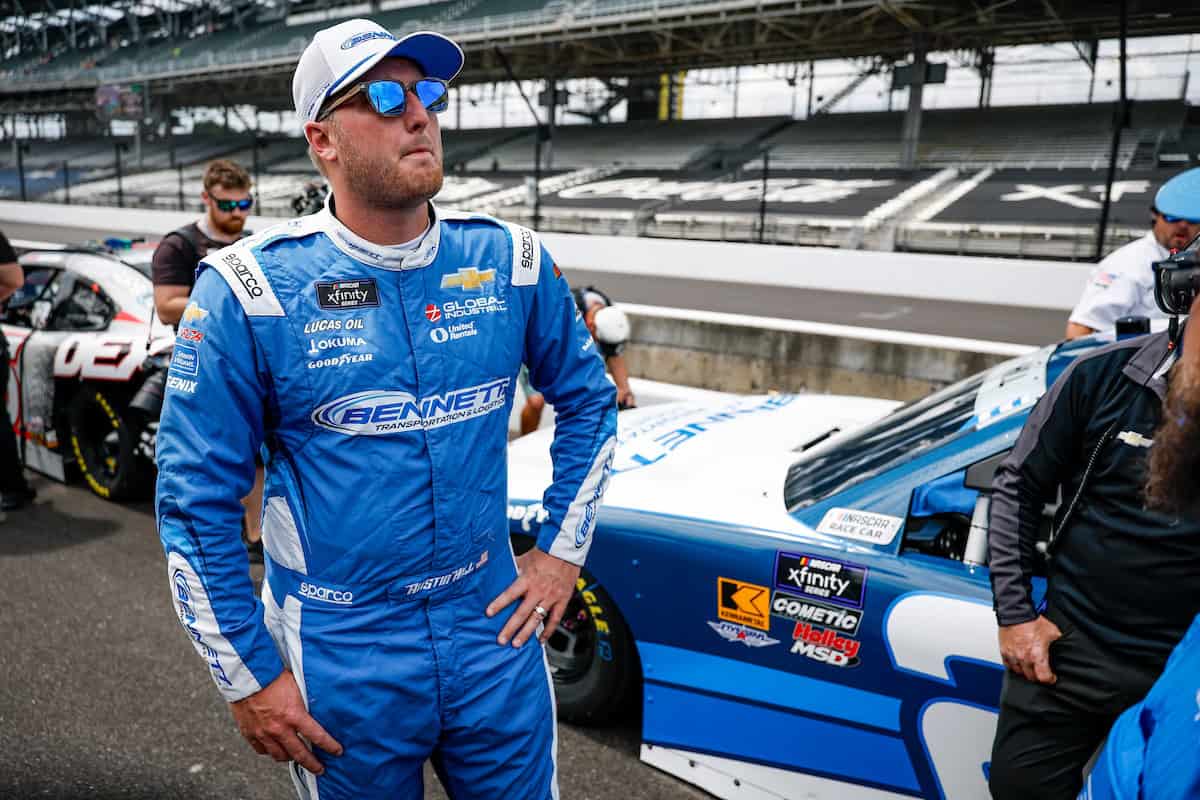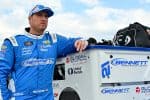Austin Hill garnered a one-race suspension from NASCAR and lost all of his regular-season playoff points for right-hooking Aric Almirola into the outside wall in the NASCAR Xfinity Series race at Indianapolis Motor Speedway on July 26.
Hill served his one-race timeout at Iowa Speedway, only to generate more controversy in his return at Watkins Glen International last Saturday (Aug. 9).
With nine laps to go, Hill and Michael McDowell were battling for second place as they exited the Carousel. Both drivers made use of the runoff section to navigate the turn, and they had to merge back to the racing line in order to avoid the upcoming jut of the inside guardrail.
Hill misjudged the clearance of his car when he turned right to merge and instead turned McDowell into the inside wall, which sparked a violent crash that claimed at least a dozen cars and red-flagged the race for nearly an hour.
Hill’s move was reckless at best, but it was clearly an accident, and NASCAR’s Senior Vice President of Competition Elton Sawyer didn’t view it as malicious.
Therefore, no further action was taken by NASCAR.
But for a driver who had just been reinstated from a behavioral suspension, triggering that accident was probably the worst thing Hill could’ve done in his return, aside from intentionally wrecking someone else.
The past week begs the following question: was Hill’s one-race suspension enough of a punishment, or did the events of Watkins Glen prove otherwise? – Stephen Stumpf
Hard Racing Doesn’t Mean He Hasn’t Learned
While I think we can all agree that while Hill raced aggressively with both Connor Zilisch and McDowell at Watkins Glen International on Saturday, it doesn’t mean that he hasn’t learned anything from a week’s vacation.
Hill made it clear before the race that he was not going to change his driving style because of the suspension, and he shouldn’t — mostly. There’s a difference between driving aggressively and driving in over your head. What Hill did at Indianapolis was the latter.
He shouldn’t stop pressing the attack on drivers just because he was told an obvious right hook wasn’t allowed.
As The CW’s broadcast indicated during pre-race Saturday, the only person who really knows what happened in the incident with Almirola is Hill himself, and that we need to take him at his word and either believe him or don’t.
Similarly, Hill was very candid in his post-race interview after shipping Zilisch in turn 1 for the lead and eventually wrecking McDowell coming out of the Carousel.
Unlike the incident with Almirola, Hill admitted fault for his role in what happened with the McDowell accident, saying that he “could’ve lifted” more than he did to avoid hooking McDowell and mentioned that he didn’t mean to send Zilisch so wide when they were battling for the lead in turn 1.
Say what you want about Hill, but he did take responsibility for what happened on Saturday. It’s something he didn’t do with Almirola, nor with his run-in with Cole Custer, nor with his tangle with former teammate Sheldon Creed at Martinsville Speedway in the fall of 2023.
Hill is a driver who wears his heart on his sleeve and is unashamed of the way he drives. When he stands up and says, “I’ll take the blame” in a circumstance where he knows he’s already in hot water with NASCAR, it shows where he’s learned to be more levelheaded.
Is his attitude still a problem?
Maybe.
Is he still overaggressive? More than likely. But using what happened at Watkins Glen as fodder for saying that he didn’t learn anything isn’t fair when Watkins Glen is the only race he’s competed in since his suspension.
Let the freshness of the suspension wear off, especially as we head to one of his best tracks in Daytona International Speedway, before judging whether or not the idea of a one-race suspension was enough. If he continues to make overaggressive decisions and reverts back to being, for lack of a better term, “a complete butthead” (as Kyle Busch called himself at Circuit of the Americas), then we can have a greater discussion on whether or not one race was enough.
Besides, the incident with Almirola was only the second time Hill has outright intentionally wrecked a driver, and the first time since he did it to Custer early in 2024.
You could make the argument that he had some intentional part of the meltdown with Creed at Martinsville Speedway in 2023, but that final lap was a disaster for so many people that it’s hard to judge.
My point being that Hill is nowhere near someone like Carson Hocevar, who, although talented, has a track record of suspicious “unintentional” crashes of either himself or other drivers. The suspension for wrecking Almirola, while warranted, was not a culmination of multiple incidents of micro-intentional crashing; it was NASCAR’s typical reaction to a right hook at a high-speed track.
With every driver who has been suspended for a right hook, we’ve seen them change nothing about their driving style, while simultaneously not repeating the action they were suspended for. Hill may not be any different — Watkins Glen’s incidents were a result of hard racing and minor lapses in judgment, not a result of retaliation.
Hill has likely learned from Indianapolis. We just have to give him more than a one-race sample size to determine that. – Anthony Damcott
NASCAR Should Have Laid Down the Law
Motorsports are inherently dangerous.
Whether someone is strapping into a car in one of NASCAR’s three primary touring series or at their local short track on a Saturday night, there is a risk involved.
NASCAR strives to keep their series as safe as possible and mitigate the risks that drivers face.
The punishment for a driver intentionally right-hooking a competitor is typically a one-race suspension and a forfeiture of playoff points for missing a race, which is the penalty Hill received for his actions at Indianapolis, when he turned Almirola into the turn 4 wall.
This is a case where the penalty should have been more, and NASCAR should have set a precedent of what happens when a driver hooks someone at a high-speed track.
The track where Hill committed the infraction was Indianapolis, where the turns are so tight that when a driver is sent to the wall, they have little to no time to react, and long straights allow drivers to reach high speeds before making entry into the corners.
In fact, all parties involved in the incident were lucky that the NASCAR Xfinity Series runs the superspeedway aero package at Indianapolis, or else the incident could have been worse.
Even with the superspeedway aero package, Almirola described the wreck in his interview after the incident as one of the hardest hits in his career and compared it to his crash in 2017 at Kansas Speedway, where he suffered a back injury.
Hill returned from his suspension at Watkins Glen International, another high-speed track that is considered one of the more dangerous tracks NASCAR goes to.
Hill was asked about the Indianapolis crash by the CW pre-race at Watkins Glen, where he expressed that he would not be changing his style and that the wreck was unintentional.
“I’ll probably get backlash for it, but absolutely not,” Hill said. “I’m going to still race the way I always do. I’m a hard-nosed racer. It was fully unintentional. It’s easy for me saying that right now with it being two weeks out, but I’m an extremely honest person.”
As we all know, Hill sparked a wreck on lap 74 of the Xfinity race at Watkins Glen.
While I do not oppose hard racing, causing a massive crash at an incredibly dangerous road course just after returning from a suspension for intentional wrecking reflects poorly on Hill, especially considering that this was not his first encounter with such issues.
Hill was disciplined following the Xfinity Series race at Charlotte Motor Speedway in 2024 for spinning Custer out after they had wrecked. Hill escaped a suspension for that incident, and as many have pointed out, it appears that no penalty handed down from NASCAR has yet to make Hill learn from his mistakes.
So what can NASCAR do to get through to Hill?
Take away his ability to race for a championship, and that would have meant denying his playoff waiver for missing a race. It has gotten to the point where I wonder what a driver even has to do on track to get denied a playoff waiver, because NASCAR is yet to deny one for an on-track incident.
NASCAR implemented a new rule for the 2025 season, which says that a driver missing a race without a valid reason means a forfeiture of playoff points.
Suspensions fall under an invalid reason, but I still argue that this punishment is not enough for hooking a driver at Indianapolis and then denying any responsibility.
If NASCAR had done that, they would have had to explicitly state that the new precedent is that whoever intentionally wrecks someone at high-speed tracks or high-speed sections of the track gets their playoff waiver denied.
Taking away a driver’s chance at a championship is the most effective way to get through to them, and I am almost certain it would have caused Hill to clean up his driving a little and likely would have prevented the melee at Watkins Glen.
That may sound extreme, but there is no extreme when it comes to driver safety. – Logan Kendall
Stephen Stumpf is the NASCAR Content Director for Frontstretch and is a three-year veteran of the site. His weekly column is “Stat Sheet,” and he formerly wrote "4 Burning Questions" for three years. He also writes commentaries, contributes to podcasts, edits articles and is frequently at the track for on-site coverage.
Find Stephen on Twitter @stephen_stumpf
Logan Kendall joined the Frontstretch team in 2025 as the Tuesday News Writer and fills in other roles as needed. He resides in the Finger Lakes region of New York and spends his free time writing as a hobby creatively and is a self published author.
Logan can be found on X @LoganKendall48
Anthony Damcott joined Frontstretch in March 2022. Currently, he is an editor and co-authors Fire on Fridays (Fridays); he is also the primary Truck Series reporter/writer and serves as an at-track reporter. He has also assisted with short track content and social media, among other duties he takes/has taken on for the site. In 2025, he became an official member of the National Motorsports Press Association. A proud West Virginia Wesleyan College alum from Akron, Ohio, Anthony is now a grad student. He is a theatre actor and fight coordinator in his free time.
You can keep up with Anthony by following @AnthonyDamcott on X.






